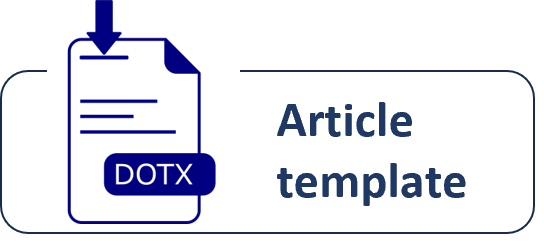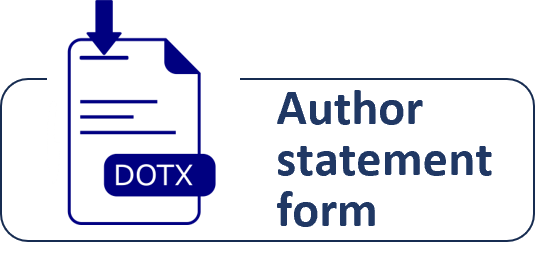JOURNAL INFORMATION
Instruction for Authors
Download Author Guidelines: | in English | (.pdf) last update April 11, 2024
General guidelines
- Articles submitted for publication in Current Biomedicine must be original, in accordance with the scope of the journal, and have not been published or submitted in any journal, whether in a proceeding, scientific journal, or any form of publication. Articles must be free from plagiarism, misrepresentation, and falsification practices. The editor will check for plagiarism.
- Articles can be written in good English.
- Articles proposed for publication include research, reviews, case studies, or short communication.
- The proposed article does not contain things that violate the rules of bioethical research.
- The article is written in article template using Microsoft Word, with an A4 page size (210×297 mm). The left margin is 2.5 cm, top 3 cm, right 2 cm, and bottom 2 cm. All parts of the text in the manuscript are written using Times New Roman and single spaced.
- Tables and figures are placed in appropriate locations in the text. Tables and Figures are placed after the first mention in the sentence (text). Titles and text in tables, as well as titles and descriptions of images, use 10 pt font size, single-spaced. The description below the table uses a font size of 8 pt.
- Articles are written in order: Title, author's name, affiliation/institution, abstract, keywords, introduction, methods, results, discussion, conclusion, and references.
- Articles are submitted only via the online system at: https://journal.ipb.ac.id/index.php/currbiomed. The author could send an email for any questions or help to Email address: currbiomed@apps.ipb.ac.id.
Specific guidelines
Article type.
Research. A research article is a complete study of a research activity or part of a research with a complete study of the topic. The article must meet scientific principles, including experimental design and adequate statistical analysis. The study must meet the bioethical aspects of research. Meta-analytical studies and epidemiological studies are included in the category of research articles. Research articles use subtitles consisting of Introduction, Materials and Methods, Results, Discussion, and Conclusions.
Review. A review article is comprehensive, critical-analytical, provides current information on a topic, or contains forward-looking views on a problem. The review article must provide the latest information from previous studies, convey the author's analysis and critical study of the collection of facts or data, and conclude it into an acceptable view or one that will be used for future development. Review articles use subtitles that suit the author's needs, starting with the Introduction and ending with Conclusions/ Recommendations/ Future Perspectives.
Case study. A case study article is a report of an incident or case in the clinical, pathological, or other fields deemed necessary to be published but insufficient to be written as a research paper. Case study articles that provide new information or additional contributions to the existing literature are preferred. Case study articles use subtitles: Introduction, Case Description, Intervention and Therapy, Discussion, and Conclusions.
Short communication. A short communication article concerns a relatively new idea or research result that only qualifies as a partial research article. Short communication articles that contain the latest information and help develop or apply a science. Short communication articles remain in a format like other articles (adapted to their type, but without subtitles) and with fewer pages (approximately half or one-third the length of a regular article).
Title. The title should be short, clear, specific, and informative and reflect the manuscript's content. The maximum length of the title is about 16 words with a capital letter in the beginning title (sentence case).
Author(s). The names of all authors are written under the title in full but without a title. Authors from different institutions are assigned a different superscript letter at the end of each name. In addition, it is necessary to identify the author who is responsible for the correspondence or acts as the corresponding author.
Abstract. The abstract is written briefly with a maximum length of 250 words. Abstract writing should avoid abbreviations and not include references/libraries. The abstract must contain the background, objectives, methods, results, and conclusions.
Keywords. Keywords contain at most five words or phrases. Use phrases to make specific keyword.
Introduction. The introduction briefly explains the background of the research, which is supported by the relevant and up-to-date references/libraries (literature), and the purpose of the research/writing.
Methods. Methods are written in a detailed, clear, and complete manner and are used to ensure that other researchers can repeat or reproduce the results.
Results. Results are written separately from the discussion. Results can be presented in the form of Tables or Figures. Each existing table or figure has been mentioned in the text and numbered according to its appearance. The main results or those that support the objectives and conclusions need to be interpreted or emphasized to make it easier for the reader to understand the research results.
Use the following system for writing:
- Temperature: degrees Celsius, e.g., 37°C
- Units: International System (SI), e.g., 2 mol/L (not M or N), 20.4 mm (not inches)
- Time: e.g., 2 seconds, 4 minutes, 3 hours, five days, Day 5 (the fifth day), seven years, Year 4 (the fourth year).
- Dosage: in kg except for mice in g
- Centrifugation: in gravity (×g), avoid rpm.
- Numbers: 8.9 mm (instead of 0.089 m), 2 mol (instead of 2×10-6 mol), 2-3 g, 1 m×2 m×2 m, 8.9 ± 2.1 kg, and 11 ± 3 nmol/L.
- Percentage: 6%–7%
- Date: July 7, 2022
- Statistics: (P<0.05)
- Use the symbol (–) for meaning up to, for example, pages 2–5. Use the sign (-), e.g., day-1.
Table. The table only uses horizontal lines for column headings and table ending lines, while vertical lines are not displayed. Titles and text in tables use 10 pt font, single-spaced. Notes below the table use 8 pt font size.
Table 1 The table's title is written in sentence case
Figure. Images must be in JPEG or PDF format with a minimum of 300 dpi. Images with more than one photo/graphic are labeled with the letters A, B, C, etc., in the bottom left corner of each photo/graphic. Image titles and descriptions use a 10 pt font size. Authors may send tables or images in separate files for particular needs or printing or editing.
Figure 1 Images must be able to stand alone and be understood even though they are separate from the text. (A) What pictures and explanations; (B) What pictures and explanations; (C) What pictures and explanations; (D–F) What pictures and explanations. Explanation of symbols or abbreviations contained in the image. Magnification should use a scale line or bar, for example, bar: 100 µm. Or if forced to use multiples, for example, 100× magnification.
Discussion. The discussion is written comprehensively. The results obtained are discussed systematically and constructively to support the research objectives and strengthen the conclusions.
Conclusions. Conclusions are presented briefly, mentioning the main conclusions from the results obtained.
References. References used a maximum of the last ten years, with a minimum of 80% being journal articles. Old references that are indeed the primary or monumental references for the topic to be conveyed may be used, and the number is at most 10%.
How to write a citation in the text:
- One author: (Summit, 2022)
- Two authors: (Sasseville & Diters, 2008)
- More than two authors: (Bellantari et al., 2021)
- More than one reference, separated by a semicolon (;) and sorted by year: (Sasseville & Diters, 2008; Bellantari et al., 2021; Summit, 2022)
How to write a reference in the Bibliography:
References are listed in alphabetical order by author's name.
- Book/book chapter:
Sigit HS. 2006. Pests of Indonesian settlements. Bogor (ID): IPB Press. Pp 20–25.
Garner DL, Hafez ESE. 2000. Spermatozoa and seminal plasma. In: Hafez B, Hafez ESE (eds). Reproduction in farm animals. 7th ed. South Carolina (US): Lippincott Williams and Wilkins. Pp 96−109.
- eBooks:
Gerson AA. (Year of publication). Title [E-Reader Version]. Link http://xxxx or DOI: xxxx.
- Journal:
Kwong JC, Druce JD, Leder K. 2013. Case report: Zika virus infection acquired during brief travel to Indonesia. American Journal of Tropical Medicine and Hygiene, 89: 516–517. DOI: 10.4269/ajtmh.13-0029.
Miao Z, Wang Q, Chen D, Song Z, Zhang W, Zhou X, MacMillan DC. 2020. Current societal views about sustainable wildlife management and conservation: a survey of college students in China. Animals, 10(10): 1821. DOI: 10.3390/ani10101821.
- Article from the website:
Gerson AA. (Year, Month of publication). Article title. Link/URL. Downloaded: date.
Additional guidelines
- For research with human subjects or using animals, the authors declare in Methods about informed consent, ethical approval, or animal use ethics from the Institutional Ethical Board according to the type of research and existing regulations.
- Authors are required to declare any potential conflict of interest.
- The author describes the contribution of each author involved in the research. Only individuals who have contributed may be listed as authors. Each author is fully responsible for the integrity and correctness of the data and writing according to their respective contributions.
- The corresponding author represents all researcher members who fill out an author statement form of originality of writing and research (Author statement form). Each author has read, reviewed, and approved the manuscript to be submitted.
- The corresponding author sends a cover letter together with the main manuscript. The cover letter contains the purpose of sending the manuscript, and the significance or novelty of the research.
- All author gives the author's full name, institution, and Email address. The corresponding author includes the institution address and the telephone number or mobile phone/WA for correspondence purposes.







